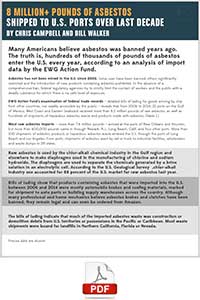8 million+ pounds of asbestos shipped to U.S. ports over last decade
Hundreds of thousands of pounds of raw asbestos, asbestos products and hazardous waste enter the country each year.
By Chris Campbell and Bill Walker Many Americans believe asbestos was banned years ago. The truth is, hundreds of thousands of pounds of asbestos enter the U.S. every year, according to an analysis of import data by the EWG Action Fund. Asbestos has not been mined in the U.S. since 2002. Some uses have been banned, others significantly restricted and the introduction o...
By Chris Campbell and Bill Walker
Many Americans believe asbestos was banned years ago. The truth is, hundreds of thousands of pounds of asbestos enter the U.S. every year, according to an analysis of import data by the EWG Action Fund.
Asbestos has not been mined in the U.S. since 2002. Some uses have been banned, others significantly restricted and the introduction of new products containing asbestos prohibited. In the absence of a comprehensive ban, federal regulatory agencies try to strictly limit the contact of workers and the public with a deadly substance for which there is no safe level of exposure.
EWG Action Fund’s examination of federal trade records – detailed bills of lading for goods arriving by ship from other countries, not readily accessible by the public – reveals that from 2006 to 2014, 23 ports on the Gulf of Mexico, West Coast and Eastern Seaboard received more than 8.2 million pounds of raw asbestos, as well as hundreds of shipments of hazardous asbestos waste and products made with asbestos. (Table 1.)
Table 1. More than 8.2 Million Pounds of Asbestos Were Imported to the U.S. from 2006 – 2014
| Port | Total Asbestos Shipments, 2006-2014* | Pounds of Raw Asbestos | Shipments of Products Containing Asbestos | Shipments of Hazardous Asbestos Waste |
|---|---|---|---|---|
| New Orleans, LA | 40 | 5,249,103 | 0 | 0 |
| Houston, TX | 42 | 2,375,254 | 9 | 0 |
| Newark, NJ | 7 | 248,280 | 11 | 0 |
| Long Beach, CA | 3 | 149,853 | 33 | 62 |
| San Juan, PR | 3 | 77,991 | 2 | 0 |
| Jacksonville, FL | 3 | 57,878 | 0 | 27 |
| Mobile, AL | 2 | 56,438 | 0 | 0 |
| Norfolk, VA | 1 | 28,219 | 2 | 0 |
| Los Angeles, CA | 0 | 0 | 48 | 2 |
| New York, NY | 0 | 0 | 19 | 0 |
| Miami, FL | 0 | 0 | 19 | 0 |
| Port Everglades, FL | 0 | 0 | 9 | 4 |
| Honolulu, HI | 0 | 0 | 0 | 11 |
| Oakland, CA | 0 | 0 | 2 | 5 |
| Port Canaveral, FL | 0 | 0 | 0 | 5 |
| Seattle, WA | 0 | 0 | 4 | 0 |
| Charleston, SC | 0 | 0 | 4 | 0 |
| Morgan City, LA | 0 | 0 | 1 | 3 |
| Savannah, GA | 0 | 0 | 2 | 0 |
| Baltimore, MD | 0 | 0 | 1 | 1 |
| Tacoma, WA | 0 | 0 | 1 | 1 |
| Pascagoula, MS | 0 | 0 | 0 | 2 |
| Fort Pierce, FL | 0 | 0 | 0 | 1 |
| Total | 101 | 8,243,016 | 167 | 124 |
* Includes Raw Asbestos, Products Containing Asbestos and Hazardous Asbestos Waste
Source: EWG Action Fund, from Trade Navigator, Ealing Market Data Engineering Co., 2006-2014.
Most raw asbestos imports – more than 7.6 million pounds – arrived at the ports of New Orleans and Houston, but more than 600,000 pounds came in through Newark. N.J., Long Beach, Calif. and four other ports. More than 100 shipments of asbestos products or hazardous asbestos waste entered the U.S. through the ports of Long Beach and Los Angeles. From ports, shipments of asbestos went by rail or truck to industrial facilities, wholesalers and waste dumps in 29 states.
- Raw asbestos is used by the chlor-alkali chemical industry in the Gulf region and elsewhere to make diaphragms used in the manufacturing of chlorine and sodium hydroxide. The diaphragms are used to separate the chemicals generated by a brine solution in an electrolytic cell. According to the U.S. Geological Survey1, chlor-alkali industry use accounted for 88 percent of the U.S. market for raw asbestos last year.
- Bills of lading show that products containing asbestos that were imported into the U.S. between 2006 and 2014 were mostly automobile brakes and roofing materials, marked for shipment to auto parts or building supply warehouses across the country. Although many professional and home mechanics believe asbestos brakes and clutches have been banned, they remain legal and can even be ordered from Amazon.
- The bills of lading indicate that much of the imported asbestos waste was construction or demolition debris from U.S. territories or possessions in the Pacific or Caribbean. Most waste shipments were bound for landfills in Northern California, Florida or Nevada.
Precise data are elusive
But port records do not account for all asbestos entering the U.S.
They don’t include asbestos imported by air from overseas, or by rail or truck from Canada, where asbestos is still mined, and Mexico, where its use is largely unrestricted. Manifests contain many errors and misidentify some shipments. EWG Action Fund obtained port records through a paid subscription to the Ealing Market Data Engineering Co.’s Trade Navigator,one of several proprietary services that republishrecords from the Census Bureau. But we found that these records are not complete because names and locations of shipper or recipients could be concealed by application to U.S. Customs and Border Protection.
The bottom line: neither the government nor the public can track with certainty all asbestos coming in or where it goes.
The U.S. Geological Survey estimates that in 2013, the latest figures available for a full year, the U.S. used more than 1.7 million pounds of raw asbestos, a decrease of 24 percent from 2012. The estimate includes 2013 imports plus use of asbestos from previously imported stocks. The value of the imported raw asbestos was $1.16 million. Products containing asbestos were evaluated at $4.94 million.
In its most recent annual minerals report, the Geological Survey says that last year, the U.S. used about 882,000 pounds of asbestos, an estimate based only on imports through the first half of the year. It said that 95 percent of the raw asbestos arriving in the U.S. came from Brazil, one of the world’s leading producers and users. (In 2013, the nonprofit Asbestos Disease Awareness Organization reported that asbestos mining in Brazil is partially funded by U.S. investors including Mellon Capital Management, the Vanguard Group and State Street Global Advisors.)
But port records show that about 964,000 pounds of raw asbestos were imported in 2014, leaving more than 82,000 pounds unaccounted for by the Geological Survey’s estimate.
Some of the difference may be mean that previously imported asbestos is being re-exported. The Geological Survey says about annual 59,000 pounds of raw asbestos, and asbestos products worth $33.4 million, were re-exported from the U.S. in 2013 – an increase of 27 percent over 2012, with Mexico and South Korea the leading destinations. As of mid-February of this year, re-export figures for 2014 were not available.
Robert Virta, a Geological Survey mineral commodity specialist, told EWG Action Fund that the agency’s information comes from the U.S. Census Bureau. But he said the Census Bureau is largely dependent on the information shippers disclose on the bills of lading. The information is often difficult to verify; an error may be caught only when a third party draws attention to it.
For example, the Geological Survey’s annual Mineral Commodity Summaries say that in 2014, five percent of imported asbestos – two shipments totalling seven tons – came from Australia, which had banned the mineral in 2003. The nonprofit International Ban Asbestos Secretariat queried Australian authorities and verified that asbestos is no longer mined there. A Geological Survey spokesman told the group:
The first and most likely explanation is that some other product was reported under the HTS [Harmonized Tariff Schedule] code for asbestos. Unfortunately, the Census Bureau does not release enough information about the shipments to verify this supposition. A second option is that the shipments may have been asbestos from China that was being handled by an Australian-owned company with the shipment incorrectly attributed to Australia. . . . It also isn’t likely that the shipment was asbestos waste material for disposal owing to the costs.
Whatever the reason, the bottom line is this: last year seven tons of asbestos entered the U.S., and the U.S. government can’t say where it came from, exactly what it was, or where it ended up.
Obtaining more precise information about asbestos imports would require a Freedom of Information Act request to the Census Bureau or Customs.
Even the smallest amount is dangerous
Although U.S. import and use figures continue to decline, the evidence is clear that exposure to even the smallest amount of asbestos in any form is dangerous. It can cause asbestosis, an excruciatingly painful scarring of the lungs, conventional lung cancer and mesothelioma, an always-fatal malignancy that can strike the lungs, heart, gastrointenstinal sytem and testicles. As the U.S. Occupational Safety & Health Administration says on its website:
There is no “safe” level of asbestos exposure for any type of asbestos fiber. Asbestos exposures as short in duration as a few days have caused mesothelioma in humans. Every occupational exposure to asbestos can cause injury of disease; every occupational exposure to asbestos contributes to the risk of getting an asbestos related disease.
While OSHA’s job is to protect workers, asbestos poses risks to workers and consumers alike. In 2010 the Collegium Ramazzini, an international society of doctors and scientists who examine critical issues in occupational and environmental medicine, said:
The scientific community is in overwhelming agreement that there is no safe level of exposure to asbestos. Moreover, there is no evidence of a threshold level below which there is no risk of mesothelioma.
The term asbestos refers to six types of mineral fibers. According to the Geographical Survey, the only type of asbestos still used in the U.S. is chrysotile, which the asbestos industry has long claimed is less dangerous and can be handled safely with proper precautions. However, the Collegium says:
Numerous epidemiologic studies, case reports, controlled animal experiments, and toxicological studies refute the assertion that chrysotile is safe. These studies demonstrate that the so-called “controlled use” of asbestos is a fallacy.
As long as asbestos, asbestos-laden products and asbestos waste are imported into the U.S., Americans will continue to be exposed, suffer illnesses and die from this hazardous substance. The risk can be eliminated only by a total ban on asbestos.
1- All of the information from the U.S. Geological Survey cited in this report can be found in the 2013, 2014 or 2015 editions of the annual USGS Mineral Commodity Summaries. All are available at http://minerals.usgs.gov/minerals/pubs/mcs/







